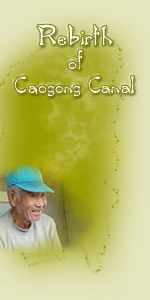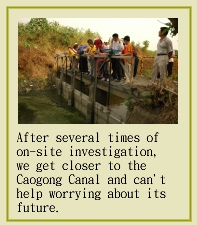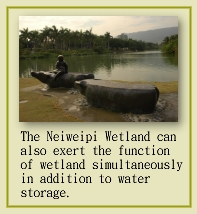 |
6.Renovation
Problem Encountered : The Vanishment of Existing Ponds and Canal Paths

After the Caogong Canal was designed to draw water from the Kao-Ping Stream, watercourses along it started to run through the areas of both Kaohsiung City and County with 4 major rivers and large ponds connected. However, because of agriculture decline and dramatically reduced irrigating function, ponds along the Caogong Canal have been deserted and silted and even some watercourses are changed or used as sewers to lose the initial function. There are many more ponds menaced by vanishment or land filling. Currently, only some ponds like Lotus Pond(park & green belt), Shetzulin Pond(lands possessed by the Farm Farm Irrigation Association), Golden Lion Lake(park green belts), Chiufanpi (National Property Bureau) and Bagualiao (possessed by Mr.Yu, Deng-Fa) are remained. Once the ponds are fully filled, the function of flood prevention is thus lost. During summer, there is torrential rain frequently, and the floods oftentimes cause problems such as the situation happening to the Benhe Village after the Ben Guan Pond was fully filled. Worsened by low land level, people never escape from bombard caused by flood.
In addition, the Neiweipi Pond was originally 30 hectares in size with a large amount of water provided for farmers. Just 10 years before, when the Art Museum was constructed, the Neiweipi Pond was dwindled to 5 hectares finally. Furthermore, the Xiao Bei Lake located in the Kaohsiung County was initially featured with the wetland available for water storage and flood prevention. However, when the Chang Gung Memorial Hospital was constructed and the lake was fully filled, the area of this wetland was thus downsized. Whenever there is any heavy rain happening now, it causes problematic flood on the west side of the Chang Gung Memorial Hospital.
Solution: The Promotion Activities for Renovation of the Caogong Canal
By focusing on the already vanished river sections for renewal review, we can evaluate whether it is featured with the meaningful accessibility to link and activate current hydrological systems with significant lecture and history implication contained. The possibility of reconstruction is also under consideration. The recommendable sites are described as below:
- The canal path of the Caogong Canal at Lotus Pond from south to Aozedi should be restored because there are some sections of canal paths without covers and inception.
- It is available to reconstruct the watercourse systems of the Caogong Canal running through Lotus Pond and to link the watercourse systems of Neiweipei. It can be constructed simultaneous with the construction engineering of underground facilities for urban railway systems or the construction engineering can be synchronized with the engineering of bicycle paths to dig new canal paths. The aforesaid consideration should be more economical and convenient than any new construction.
- After the inhabitants surrounding the Zuo Ying Old Town moved, the original site can be integrated with the Caogong Canal to act as a pond park.
- On Art Museum Road, it is available to construct canal paths and allow the Love River to link to Neiweipei Pond so that the touring boats on the Love River can go ashore right at the Art Museum.
We hope that when the renovation activities of the Caogong Canal are promoted, aside from the traditional irrigating function, the Caogong Canal can be added with below new functions:
- The green beautification along the Caogong Canal should be implemented with ample plants and it can be left with a piece of water-accessible land to create the novel scene on water shores.
- The ponds along the Caogong Canal such as Neiweipei and Niao Song Wetlands, etc can be functioned with recreation. Aside from the function with water storage, the function of wetland can be sufficiently exerted simultaneously as ecological protection, micro-climatic adjustment and underground water supplement, etc.
- When the urban development plans are under reconstruction, the original ditches can be kept intact to become the community features with clean stream water surrounding.
- At the water diverting gate of the Caogong Canal, small parks can be constructed to draw the public attention to the Caogong Canal.
- By using the water source of the Caogong Canal, the stream watercourses can be well planned for human recreation or additional conducive functions.
- By using the water from the Caogong Canal, it is available to improve the water quality of the Houjin Stream, Fong Shan Stream, Cianjhen River and the Love River, etc.
- The river banks along the Caogong Canal can be developed for water-accessible parks with the recreation function available for inhabitants' strolling and playing activities.
Reflection

The irrigation areas of the Caogong Canal actually covers overall Kaohsiung Plain and it is also the origin of 4 major rivers in Kaohsiung City. However, because of some factors like prosperous industry and commerce development, together with agriculture decline, almost every irrigation course of the Caogong Canal finally results in either stinking ditches full of industry waste water or deserted ruins. On the Kaohsiung Plain, there are numerous ponds and lakes cascaded by the Caogong Canal. Therefore, the survival of the Caogong Canal has much to do with these water ponds and lakes. However, with the effort of river renovation made by the environmental protection associations and city government teams, such as riverbank greening, water quality improvement and space development for water accessibility, the environment available for people's recreation is finally created. The environmental thinking and behaviors are quite admirable and it is still required for everyone's recognition and maintenance so that the sound environment will be perpetually kept.
|

